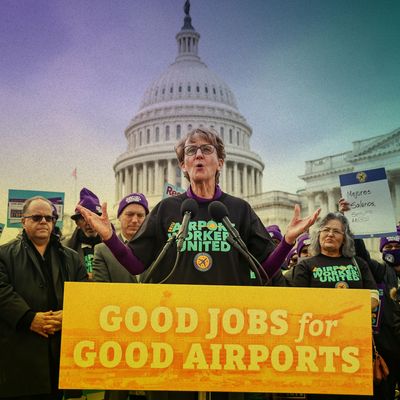SEIU’s Mary Kay Henry Modified How We Assume About Work


Photograph: Intelligencer; Photograph: Getty Pictures
By the point Mary Kay Henry stepped down from the presidency of the Service Workers Worldwide Union, she and the union had helped change how we take into consideration work. In 2012, SEIU backed putting fast-food employees within the metropolis who had been advocating for what was then a daring demand: a $15-per-hour minimal wage and a union. A decade later, the efforts of Battle for $15 and a Union led to an estimated 26 million employees profitable $150 billion in larger pay. (The marketing campaign is now referred to as the Battle for a Union.) Three years in the past, Starbucks baristas in Buffalo, New York, launched what would turn into a high-profile unionization marketing campaign with Staff United, a SEIU affiliate; now, over 400 different shops have voted to unionize. Staff led the cost. Henry lent them vital help. Now, it’s extra broadly accepted that the federal minimal wage is just too low, that unions are helpful, and that the way in which we work in America ought to rework.
She confronted vital challenges, too. In 2018, the Supreme Courtroom dominated that public employees like a lot of SEIU’s members didn’t should pay dues to cowl the prices of collective bargaining. Later, COVID offered a singular menace to frontline employees, who make up a lot of SEIU’s membership.
I spoke to Henry shortly earlier than she stepped down on Monday about her trailblazing path as the primary lady and overtly queer particular person to guide the two million member service- and care-workers union. She regarded again on her determination to again Battle for a Union, the skepticism she confronted when she did, and what’s modified for girls in organized labor. April Verrett takes up the presidency after operating unopposed for the place. She is the primary Black lady to guide the union, which is now majority individuals of colour.
Every time I speak to individuals within the labor motion, I’m all the time serious about what drew them to labor within the first place. So I’ll put that query to you: Why did you select to work in organized labor?
I used to be a group organizer on the east aspect of Detroit, and I used to be door-knocking one summer time between my first and second 12 months of school in 1976. And everyone that I door-knocked stated to me, “We don’t actually desire a handout from the federal government. We wish a hand as much as an excellent job the place we’ve a union.” And it’s because lots of the individuals within the neighborhood I used to be assigned to had been former UAW members who had been laid off by plant closures.
And so I’ve to let you know: That’s when the seed actually bought planted in my head that if I wished to revitalize downtown Detroit, I believed, possibly I ought to try to see if I may go work for the labor motion as an alternative of doing social-service work. And that’s what drew me to the labor motion. I noticed it as a option to make everlasting change in individuals’s particular person lives but in addition the bigger group that I lived in.
How has the scenario modified for girls within the labor motion over time?
Once I went to the UAW to use for a job, I used to be advised I wanted a Ph.D. in economics to work of their analysis division, or I ought to go work on an meeting line and work my method up. This lady noticed me leaving the constructing and requested what I used to be doing there, and it was Olga Madar, one of many founders of the Coalition of Labor Union Girls. I advised her my little story actually quick and he or she related me with Joyce Miller, and I bought a Greyhound bus ticket to New York. Joyce tried to rent me on a venture, however as a result of I hadn’t been a textile employee, they didn’t need me to remain there. And so she despatched me to SEIU, they usually had been all serious about pulling ladies who had been serious about working. They despatched me to a analysis place in San Francisco after which L.A., and there have been three ladies on our total govt board of 60 individuals on the time I used to be employed. It’s now half ladies immediately. And one of many three ladies referred to as me and stated, “I would like you to vow me you’ll not stop this job with out calling me, as a result of I needed to threaten to sue the president on an EEOC case if he saved hiring males on worldwide workers.”
And so we had been 4 ladies. Two ladies stop throughout the first three months, and two of us stayed and are nonetheless within the labor motion, however it’s due to a community of ladies being dedicated to tug different ladies up and into the labor motion. And so I’d say there’s been a sea change within the variety of ladies main. Liz Shuler, president of the AFL-CIO. Becky Pringle and Randi Weingarten lead training unions. And so they’ve had extra of a historical past of ladies leaders than SEIU, as a result of I’m the primary lady chief at this degree for our union. So there’s been a sea change, and I’d say we nonetheless have a protracted option to go.
Clearly, Battle for a Union had a huge effect since 2012. Are you able to clarify why you at SEIU determined to again its marketing campaign?
I’d say our union’s historical past has all the time been to make huge bets and make laborious choices and allocate sources to employees who no person thought had been organizable. So we backed the Justice for Janitors motion within the ’80s, they usually had been immigrant part-time employees who no person thought may get organized, they usually did. After which we backed within the ’90s Black, brown, and immigrant home-care employees in California, Illinois, Washington. All people thought, Oh, these are simply unbiased contractors. However we found out the right way to create employment that had dwelling wages, well being care. Some locations we’ve gained pensions, which we’re actually pleased with, and training and coaching.
Was there any skepticism about that call on the time? And if there was, how did you deal with it?
Sure, there was skepticism inside our union. There was skepticism by companion organizations and electeds in New York and across the nation. There was not skepticism by the employer. I’d say the employers began to get locked and loaded to struggle us. So the way in which we overcame it was by profitable. It was ’14 after we gained a poll initiative within the metropolis of SeaTac, which is the place the Seattle airport sits. There was a $4 million anti-campaign on this poll initiative. We gained by signing up and registering Eritrean voters, who had been the most recent group in SeaTac, and we prevailed after which they marched from SeaTac to Seattle. And the mayor’s race grew to become a referendum on whether or not Seattle was going to be the primary to go to $15 an hour.
After which, in 2015, New York and California competed to see who may signal the $15 invoice first. And I feel that degree of victory made individuals suppose, Okay, the primary a part of our demand, we’re on a roll to win. We bought blocked in southern states and in midwestern states, which we are attempting to innovate a method round. And that overcame the skepticism as a result of as wages began to go up, it completely modified the bargaining of our personal members within SEIU. So our current members skilled a profit from the motion demand for $15, and it wasn’t simply minimum-wage employees in our union that skilled it; all the employees incomes $17, $20, $21, their wages bought pushed up when the bottom wage bought to $15.
I do know you’ve been a champion of sectoral organizing for a very long time. May you clarify for readers what it’s and the way it may develop employee energy?
Properly, it takes particular person employers in a geography or throughout an trade and unites the bargaining of all these employees into one desk. And so as an alternative of organizing one fast-food retailer at a time by way of the NLRB — the place the franchisee closes the franchisor retailer or they by no means attain an settlement on a contract — we understood that we had been going to have to assist employees cut price on the energy the place the choices are made. And in order that’s what I feel is one of the best ways to consider sectoral: Take into consideration how the employers are making choices on wages and advantages after which set up the facility of the employees to have an equal say with these employers. So now we’ve half 1,000,000 employees speaking to franchise house owners in California, and my dream is that we may replicate that in lots of states after which lastly power a nationwide sectoral settlement, which is what McDonald’s, Wendy’s, and Burger King have finished in seven different nations across the globe. And there’s no motive they’ll’t make it occur right here in the USA of America.
I feel Battle for $15 and a Union has finished an unimaginable job altering the dialog across the minimal wage. It looks like the unionization half has been harder. And so I used to be questioning should you may lay out what challenges exist after we’re speaking about organizing individuals in these industries.
I feel one problem is anti-union animus by companies within the U.S. Starbucks is a basic instance of penalizing employees economically once they determined to vote for the union. McDonald’s, Wendy’s, and Burger King did the identical factor. The College of Pittsburgh Medical Middle is doing that as we communicate. There’s the penalizing of gig employees, who’re standing up, and Uber and Lyft are canceling their participation on the platform by deactivating their rides. In order that’s one impediment. A second impediment is that the legal guidelines are written in a method that limits employees’ energy. The legislation is basically about one employer, one bargaining contract, and never about sectoral. And so the principles are rigged towards employees.
That’s how we speak about it, however it’s the legal guidelines, primarily. After which the third factor I’d say is that the labor motion is a problem as a result of I feel we’ve to adapt from the commercial economic system that shaped within the ’30s to the brand new service and care economic system, which is now 80 p.c of the workforce. And with solely 10 p.c of employees being able to collectively cut price, I feel this second requires the labor motion to suppose in new and other ways about the right way to work collectively to create sectoral breakthroughs, as a result of we want organizing wins to achieve our purpose, from 10 p.c to 35 p.c of the economic system having the ability to collectively cut price. And so I’d say these are the three largest challenges. There’s different challenges, however they’re simpler to adapt to. I’ve present in my 43 years these to be three key obstacles.
Fascinated by COVID now, the virus offered an unlimited problem for organized labor, and, in fact, many SEIU members labored on the entrance traces of the pandemic. What do you suppose the pandemic possibly revealed about current inequalities within the American office particularly?
Every part.
My first thought while you stated that’s all of the individuals whose lives had been misplaced unnecessarily due to the corruption of Trump’s administration response. And I’ve to let you know: I stay livid to at the present time that so many nursing-home employees and residents unnecessarily misplaced their lives as a result of he wasn’t keen to present the discover that he bought from the Chinese language authorities. Folks didn’t have the non-public protecting gear and respirators they wanted in that first quarter of the pandemic.
And I feel it laid naked that white middle-class, white-collar employees who may stay dwelling stayed safer than the majority-minimum-wage workforce that continued to report back to work. Whether or not it was bus drivers or airport employees or health-care employees or janitors and safety officers. And that’s why, for me, the structural inequality in who does what jobs on this nation was laid naked after which housing, health-care entry, all of that, we all know that Black and brown communities died and bought sick at a disproportionate charge to their numbers due to the a part of the workforce they occupy, which is a legacy of slavery and exclusion on this nation.
In 2021, in the course of the pandemic, a Starbucks location in Buffalo, New York, unionized with Staff United, which is an affiliate of SEIU, and now we’re at over 400 Starbucks shops unionized throughout the nation. Why do you suppose this marketing campaign has been so profitable? I feel it actually captured the anger that individuals felt in regards to the choices companies like Starbucks made within the peak of COVID. That’s what I’ve heard straight from baristas, which is, once more: They had been requested to enter shops and determine the mobile-order system to guard the purchasers, however contained in the shops, they didn’t usually have the protocols wanted to guard them. And I feel it laid naked an organization that had some progressive advantages, however their precise intention was to keep up and improve their backside line — many companies earned report income due to how they tailored in the course of the pandemic. In order that’s one motive. A second motive is I feel that Starbucks employees signify the 80 p.c of parents below 30 on this nation that help collective motion.
And I feel their willingness to prepare by way of know-how and join one another and have it unfold so shortly off of the Buffalo election victory was a sign to the way forward for labor organizing that I’m extremely enthusiastic about and wish to cheer on at the same time as I exit the stage. That’s the opposite factor that I believed was unimaginable. After which the third factor is, I feel, the Starbucks employees’ embrace of variety of their management, from LGBTQ leaders within the organizing, to the leaders of colour, to white ladies and men who function in intersectional methods on points. It additionally infused the motion side of the Starbucks effort.
Fascinated by this 12 months particularly, it appears like an particularly difficult time on quite a lot of fronts, not only for organized labor however for the nation. Considering alongside these traces, many people are struggling to react to what’s happening in Israel, Gaza, proper now. In January, you launched an announcement calling for a cease-fire and the discharge of hostages, and I simply wished to know why you felt it was necessary to return out and say that.
As a result of I listened to the lived expertise of SEIU members all throughout the nation. It’s principally been pushed by our members: Sarah, just like the Israeli, Jewish RN who has a son in Tel Aviv, and who has the chance at this nurses convention to take heed to the agony of a Lebanese nurse from Minnesota, whose mother and pa had been being bombed by Israel, concurrently. And so we attain for one another’s humanity. And we perceive that working-class individuals, whether or not in Gaza or in Israel or within the U.S., are all the time on the entrance traces of paying the value by serving within the army and by our tax {dollars} getting used for this destruction.
You’ve been the president of SEIU for 14 years now. Why did it really feel like this was the correct time to step down?
I feel all the pieces we’ve talked about, the place the Battle for $15 and a Union is on this subsequent section of transferring the union demand and I really feel actually pleased with the step ahead we made in California quick meals and Minnesota nursing properties — it’s time for the following era to take the union to the following period of employee energy. And I’m conscious that as a 66-year-old lady, I’m additional and additional away from that subsequent era of Starbucks employees that I feel is charting the longer term for the union.
And so I believed it was actually necessary to move a baton to the following era. And I’m extra assured than I’ve ever been about our union’s future, as a result of our union champions employees who’ve been written out and written off — and we all the time will. And I do know that the following era of multiracial union leaders in our union goes to take the struggle to the following degree, to locations that I haven’t been capable of think about. And I nonetheless have lots of power left in me, however I feel it’s a very key second for the following management group to take cost.
This interview has been shortened for size and readability.






